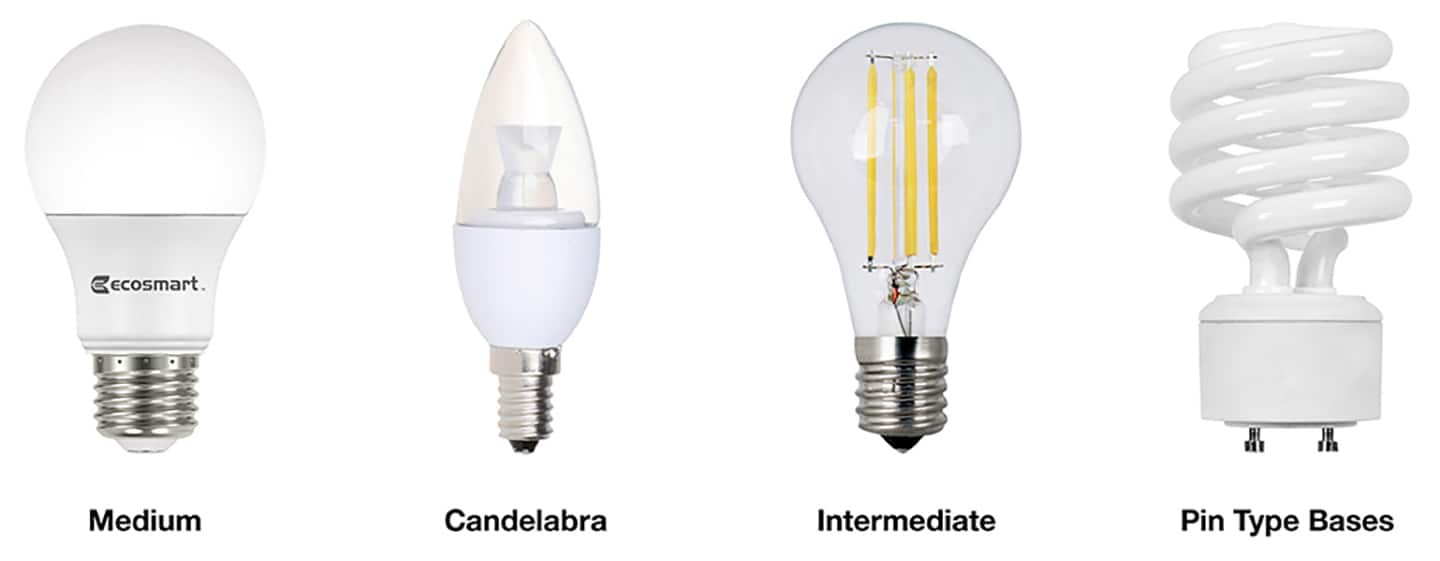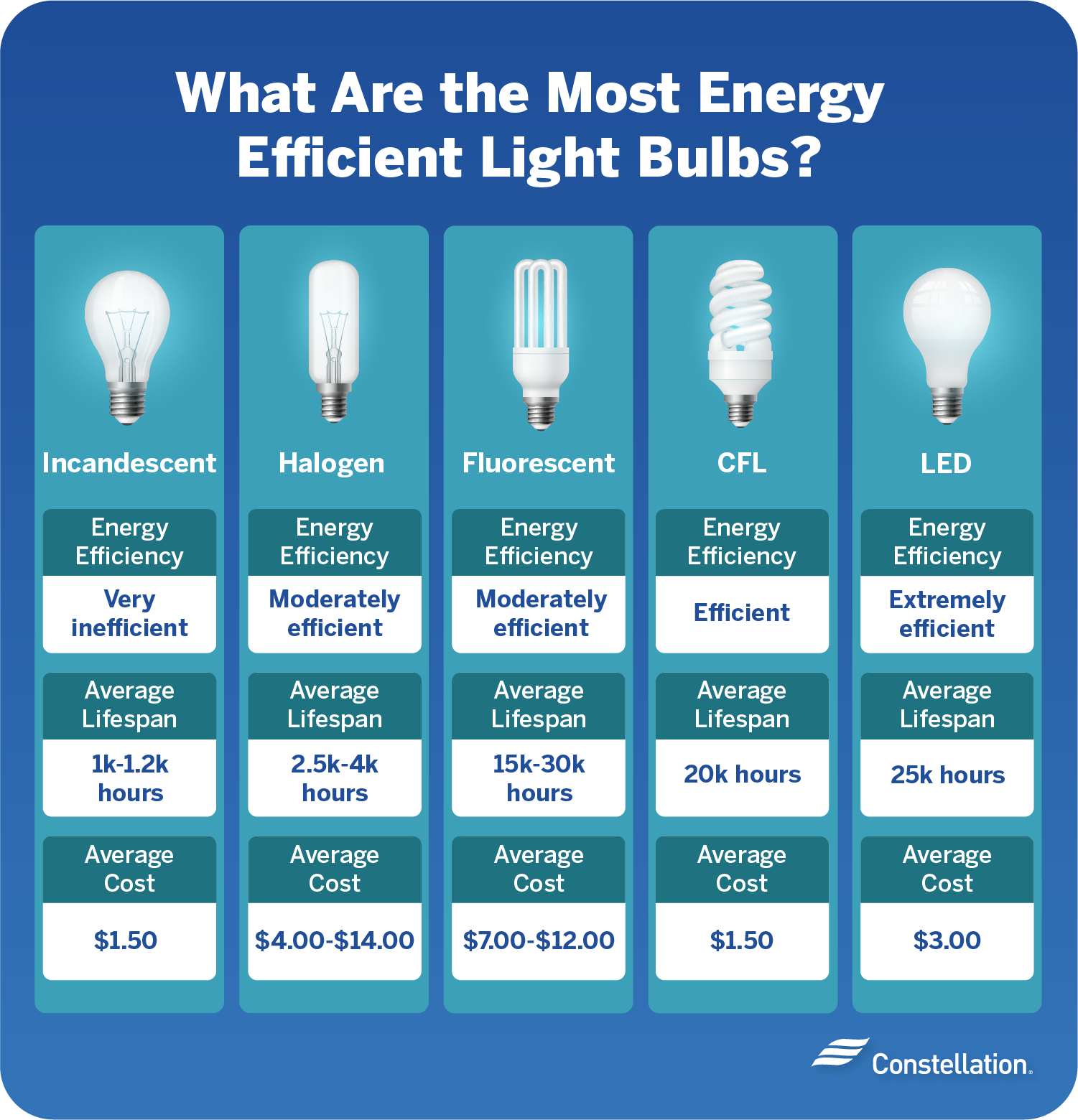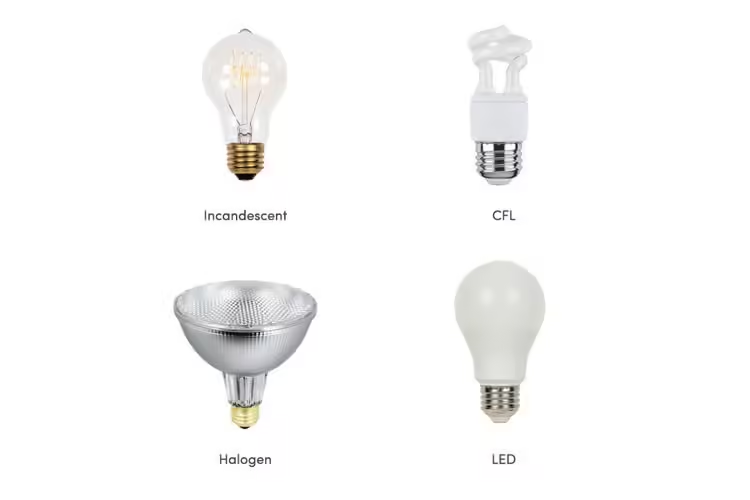How Many Different Light Bulbs are There, including incandescent, LED, CFL, and halogen. Each type offers unique benefits and applications.
Light bulbs come in various types, each suited for different needs. Incandescent bulbs are traditional and offer warm light but consume more energy. LED bulbs are energy-efficient and long-lasting, making them popular for modern usage. CFL bulbs provide energy savings and are a good middle ground between incandescent and LED options.
Halogen bulbs offer bright, white light and are often used in outdoor and security lighting. Choosing the right light bulb depends on your specific requirements, such as energy efficiency, brightness, and lifespan. Understanding these differences helps in making an informed decision for both residential and commercial lighting needs.

Credit: www.wayfair.com
Introduction To Light Bulbs
Light bulbs have revolutionized the way we live and work. They bring light to our homes, offices, and streets, making life more convenient and productive. There are many different types of light bulbs available today, each with its own unique features and uses.
Brief History
Light bulbs have a fascinating history. The first practical electric light bulb was invented by Thomas Edison in 1879. His invention used a carbon filament that glowed when an electric current passed through it. This invention paved the way for modern electric lighting.
Over the years, light bulbs have evolved significantly. From incandescent bulbs to fluorescent, and now LED bulbs, technology has improved. Each new type of bulb has brought increased efficiency and longevity.
Importance In Modern Life
Light bulbs are essential in modern life. They provide light, which is critical for daily activities. Without light bulbs, many tasks would be difficult or impossible to perform after sunset.
Light bulbs come in various forms to suit different needs. Some bulbs are designed for general lighting, while others are for specific purposes like reading or working. The variety ensures that there is a light bulb for every situation.
Energy efficiency is another important aspect. Modern light bulbs like LEDs consume less power and last longer. This helps in reducing electricity bills and environmental impact.
| Type of Light Bulb | Features |
|---|---|
| Incandescent | Traditional, warm light, short lifespan |
| Fluorescent | Energy-efficient, longer lifespan, cooler light |
| LED | Highly efficient, very long lifespan, various colors |
Choosing the right light bulb can make a significant difference. It impacts both your energy consumption and the quality of light you get. Understanding the different types of light bulbs can help you make an informed decision.
Incandescent Bulbs
Incandescent bulbs are one of the oldest types of light bulbs. They have been used for over a century. These bulbs are known for their warm light and simplicity.
How They Work
Incandescent bulbs work by heating a filament inside the bulb. When electricity passes through the filament, it heats up and glows. This glow produces light.
The filament is usually made of tungsten. It is enclosed in a glass bulb filled with inert gas. This gas prevents the filament from burning out quickly.
Advantages And Disadvantages
Advantages:
- Warm light: Provides a cozy and inviting atmosphere.
- Instant on: Lights up immediately when switched on.
- Low cost: Generally cheaper than other types of bulbs.
Disadvantages:
- Energy inefficiency: Consumes more electricity compared to other bulbs.
- Short lifespan: Burns out faster than modern bulbs.
- Heat production: Generates a lot of heat, which can be wasteful.
Here is a quick comparison:
| Aspect | Incandescent Bulbs |
|---|---|
| Light Quality | Warm and inviting |
| Energy Use | High |
| Lifespan | Short |
| Cost | Low initial cost |
Halogen Bulbs
Halogen bulbs are a popular type of light bulb. They are known for their bright and crisp light. These bulbs are more efficient than traditional incandescent bulbs. Halogen bulbs are widely used in various applications.
Functionality
Halogen bulbs work by using a tungsten filament. The filament is surrounded by halogen gas. The gas helps to increase the bulb’s lifespan. Halogen bulbs produce a bright and white light. They are more efficient than incandescent bulbs but less efficient than LEDs.
| Feature | Halogen Bulbs |
|---|---|
| Light Quality | Bright and white |
| Energy Efficiency | More efficient than incandescent |
| Lifespan | Longer than incandescent |
Common Uses
Halogen bulbs are used in many settings. They are often found in car headlights. Their bright light helps drivers see better at night. Halogen bulbs are also used in household lighting. They are great for desk lamps and reading lights.
- Car headlights
- Desk lamps
- Reading lights
- Outdoor floodlights
Halogen bulbs are versatile and useful in many applications. They provide bright, efficient lighting wherever needed.
Fluorescent Bulbs
Fluorescent bulbs are a popular choice for many households and businesses. They provide bright light and are known for their energy efficiency. Understanding how they work and their benefits can help you make better lighting choices.
Mechanism
Fluorescent bulbs use a different mechanism compared to traditional bulbs. They contain a gas that produces ultraviolet light when electrified. This ultraviolet light then interacts with a phosphor coating inside the bulb. The phosphor coating converts the ultraviolet light into visible light.
Here’s a simple breakdown of how fluorescent bulbs work:
- An electric current passes through the gas.
- The gas emits ultraviolet light.
- The phosphor coating converts UV light to visible light.
Energy Efficiency
Fluorescent bulbs are known for their energy efficiency. They use less electricity than incandescent bulbs. This makes them a cost-effective option for long-term use. Here are some key points about their energy efficiency:
| Bulb Type | Energy Consumption | Lifespan |
|---|---|---|
| Incandescent | 60 watts | 1,200 hours |
| Fluorescent | 15 watts | 10,000 hours |
Switching to fluorescent bulbs can reduce your electricity bill. They last longer, meaning fewer replacements.
Use fluorescent bulbs to save energy and money. They are a smart choice for sustainable living.
Compact Fluorescent Lamps (CFLs)
Compact Fluorescent Lamps (CFLs) are energy-efficient alternatives to traditional incandescent bulbs. They use less electricity and last longer. CFLs have gained popularity for their cost-saving benefits and environmental advantages.
Design And Features
CFLs are designed with a coiled or spiral tube. This design allows them to fit in standard light sockets. CFLs come in various shapes and sizes. They emit a range of light colors, from soft white to daylight.
Most CFLs have an internal ballast. This component helps to regulate the current and start the lamp. CFLs are also available in dimmable versions, providing flexibility in lighting control.
| Feature | Details |
|---|---|
| Shape | Spiral, U-shaped, globe |
| Color Temperature | Soft white, cool white, daylight |
| Base Type | Standard screw base, pin base |
Environmental Impact
CFLs use about 70% less energy than incandescent bulbs. This reduces greenhouse gas emissions. Using CFLs can significantly lower electricity bills.
Despite their benefits, CFLs contain small amounts of mercury. Proper disposal is essential to avoid environmental harm. Many recycling programs accept CFLs to ensure safe handling.
Switching to CFLs contributes to energy conservation. It also helps reduce the carbon footprint. Choose CFLs for a more sustainable lighting solution.

Credit: www.homedepot.com
Light Emitting Diodes (LEDs)
Light Emitting Diodes, commonly known as LEDs, have revolutionized lighting. They are energy-efficient and long-lasting. With a variety of shapes and sizes, LEDs offer versatile lighting solutions.
Technology
LEDs use a semiconductor to produce light. When an electric current passes through, it emits light. This process is called electroluminescence. LEDs can produce many colors without filters. They are also cool to the touch, unlike traditional bulbs.
Benefits
LEDs offer numerous benefits:
- Energy Efficiency: LEDs use up to 90% less energy than incandescent bulbs.
- Long Lifespan: They can last up to 25,000 hours or more.
- Durability: LEDs are resistant to shock and vibration.
- Environmental Impact: They contain no mercury and are recyclable.
LEDs are versatile and come in various designs:
| Type of LED | Use Case |
|---|---|
| Standard LED Bulbs | General household lighting |
| LED Tubes | Office and industrial lighting |
| LED Strips | Decorative and accent lighting |
Switch to LEDs for a brighter, greener future.
Smart Bulbs
Smart bulbs are revolutionizing the way we light our homes. These bulbs offer innovative features and seamless integration with smart home systems.
Innovative Features
Smart bulbs come with a range of innovative features:
- Remote Control: Control your lights from anywhere using a smartphone.
- Customizable Colors: Choose from millions of colors to set the mood.
- Scheduling: Set timers to turn lights on and off automatically.
- Energy Efficiency: Save energy with LED technology and smart scheduling.
- Voice Control: Use voice commands to control lights through smart assistants.
Integration With Smart Homes
Smart bulbs integrate seamlessly with various smart home systems:
| Smart Home System | Compatible Features |
|---|---|
| Amazon Alexa | Voice control, routines, and remote access |
| Google Home | Voice control, scheduling, and remote access |
| Apple HomeKit | Voice control, automation, and remote access |
Smart bulbs work with these systems to enhance your living experience. Voice control allows hands-free operation. Scheduling ensures lights turn on and off at set times. Automation creates a seamless, efficient home environment.
Specialty Bulbs
Specialty bulbs are unique light bulbs designed for specific purposes. These bulbs come in various shapes, sizes, and functions. They cater to specific needs not met by standard bulbs.
Types And Uses
Specialty bulbs serve many purposes. Each type has a unique function. Here are some common types:
- Black Light Bulbs: Used for parties and detecting fake currency.
- Bug Lights: Emit yellow light to attract fewer bugs.
- Colored Bulbs: Ideal for decorative lighting and holidays.
- Plant Grow Bulbs: Provide light for indoor gardening.
- Refrigerator Bulbs: Designed to withstand cold temperatures.
- Heat Lamps: Often used in bathrooms and food service.
- Smart Bulbs: Controlled via apps for advanced features.
Each of these bulbs has a special use case. They enhance the functionality of lighting in different environments.
Considerations For Purchase
When buying specialty bulbs, consider the following factors:
| Factor | Importance |
|---|---|
| Purpose | Ensure the bulb fits your specific needs. |
| Wattage | Check the required energy consumption. |
| Compatibility | Make sure the bulb fits your fixture. |
| Color Temperature | Choose the right ambiance for your space. |
| Brand | Opt for trusted brands for reliability. |
Selecting the right specialty bulb enhances your lighting experience. Pay attention to these factors for the best results.
Choosing The Right Bulb
Choosing the right bulb can be confusing. There are many types available. Each type has its own benefits and drawbacks. This guide will help you decide which bulb suits your needs best.
Factors To Consider
There are several factors to consider when choosing a light bulb:
- Brightness: Measured in lumens. Higher lumens mean more brightness.
- Color Temperature: Measured in Kelvin. Warm light is around 2700K, cool light is around 5000K.
- Lifespan: LED bulbs last longer than incandescent bulbs.
- Energy Efficiency: LED and CFL bulbs use less energy than incandescent bulbs.
- Cost: LEDs cost more upfront but save money in the long run.
Energy Savings Tips
Want to save on your electricity bill? Follow these energy-saving tips:
- Switch to LED or CFL bulbs. They use less energy.
- Turn off lights when not in use. This simple step saves energy.
- Use dimmer switches. They allow you to adjust the brightness and save energy.
- Install motion sensors. They turn lights on and off automatically.
- Consider smart bulbs. They can be controlled remotely and are energy-efficient.
Here’s a quick comparison of different types of bulbs:
| Type of Bulb | Lifespan (hours) | Energy Use (watts) | Cost ($) |
|---|---|---|---|
| Incandescent | 1,000 | 60 | 1 |
| LED | 25,000 | 10 | 3 |
| CFL | 8,000 | 14 | 2 |
Future Of Light Bulbs
The future of light bulbs is incredibly exciting. New technologies are emerging every year. These advancements promise more efficient and eco-friendly lighting solutions. Understanding these trends helps us prepare for a bright future.
Emerging Technologies
Several cutting-edge technologies are reshaping the light bulb industry. They offer improved performance and sustainability.
- LED Innovations: LED bulbs are becoming more advanced. They last longer and use less energy.
- Smart Bulbs: These bulbs can be controlled with smartphones. They offer customization and convenience.
- Organic LEDs (OLEDs): OLEDs provide better color accuracy and thinner designs.
Trends To Watch
Several trends are influencing the light bulb market. Keeping an eye on these trends can help you stay updated.
- Energy Efficiency: More focus is on reducing energy consumption. Bulbs are becoming more eco-friendly.
- Smart Home Integration: Light bulbs are now part of smart home systems. They offer voice control and automation.
- Sustainability: Manufacturers are using eco-friendly materials. This reduces environmental impact.
| Technology | Advantages | Drawbacks |
|---|---|---|
| LED | Long life, low energy use | Higher upfront cost |
| Smart Bulbs | Remote control, customization | Requires smart devices |
| OLED | Better color, thin design | Expensive |

Credit: blog.constellation.com
Frequently Asked Questions
How Many Different Types Of Lights Are There?
There are several types of lights, including LED, fluorescent, incandescent, halogen, and smart bulbs. Each type offers different benefits.
What Are The Different Types Of Bulbs?
There are several types of bulbs: incandescent, LED, CFL, halogen, and smart bulbs. Each offers different benefits and energy efficiency.
How Many Different Light Bulb Bases Are There?
There are several types of light bulb bases. Common ones include Edison Screw, Bayonet, Bi-pin, and GU10. Different regions may use different standards.
How Many Types Of Bulb Holders Are There?
There are several types of bulb holders, including screws (Edison), bayonets, pin, and wedge bases. Each type suits different bulbs.
Conclusion
Exploring the variety of light bulbs helps you make informed choices for your needs. From LEDs to incandescents, each type offers unique benefits. Understanding these options ensures you select the right light bulb for energy efficiency and ambiance. Brighten your space with the perfect light bulb for any setting.



